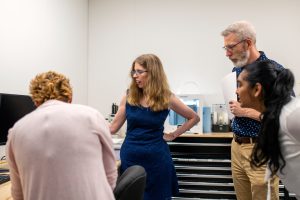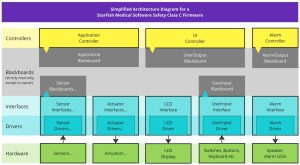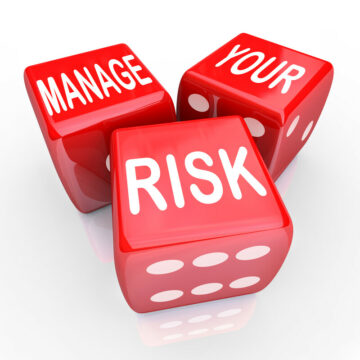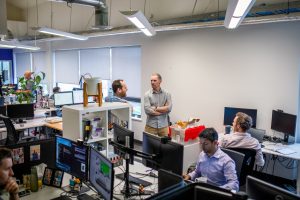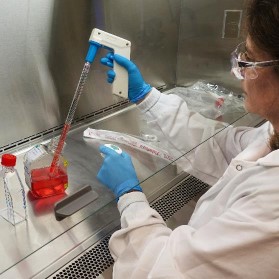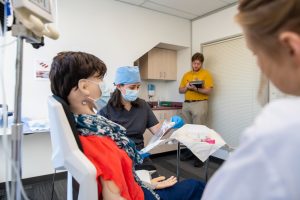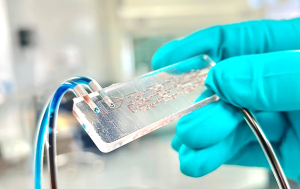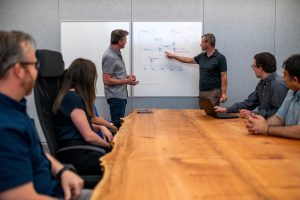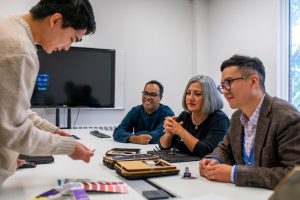 Company culture and values have a huge impact on our client relationships and work designing, developing, and manufacturing innovative medical devices.
Company culture and values have a huge impact on our client relationships and work designing, developing, and manufacturing innovative medical devices.
We asked employees to share the StarFish Medical value they use most and how it makes a difference.
- Looking Deeper
- Cutting to the Chase
- Being Open and Accountable
- Getting Better
Looking Deeper
Looking deeper for just the right amount and in just the right areas to help our clients efficiently become a more valuable company is kind of the essence of StarFish.
It’s almost like looking deeper and cutting to the chase are part of the same goal. But we must decide when do you dig deeper. And when you have dug enough, it’s time to get something done. Resources aren’t unlimited and early-stage companies often don’t have much money to work with. We need to be hyper-respectful, hyper-efficient to get them to the next valuation milestone.
There can be a real tendency to just get started, roll up your sleeves and dive into solving problems. Oftentimes people don’t think about whether it’s the right problem to solve. Looking deeper helps you focus on providing value instead of just doing work.
A client completed a substantial amount of preclinical work including human trials and provided a parameter value they were confident their treatment would achieve in every patient. Conducting a literature deep dive uncovered quite a lot of variation in this physiological parameter. The value they provided was at the lower limit and would have been very difficult and expensive to achieve 100% of the time.
One important question in any project is “Who is the product or service being designed for?” Jumping straight to what the client is requesting without considering the needs of the product or service customers, could potential lose out of opportunities.
An established client had a surgical product. Our mandate was more of a documentation mandate. As we got into the documentation and looked at their field records, we found several things that really couldn’t be ignored. That allowed us to structure a better project which created a lot more value for the client. They gained a future product runway through looking deeper.
One project did not permit the ability to look deeper because very specific direction and technologies were stipulated by the client. As the project developed, the downside of not looking deeper at the project start meant running into hurdles, backtracking to alternative designs, even going all the way back to the drawing board to evaluate whether the product was worth building. Pushing to look a little deeper in the very beginning can be done without designing all the alternatives or working out all possible routes. Instead, brainstorming can create a mental foundation that is ready if the project needs to pivot.
Looking deeper builds credibility and trust in relationships. A clinician principal with a very strong opinion about the right way to build a product took years to let human factors in and look at a workflow use case. After that exercise, their eyes opened, and the product definition was refined built upon trust.
Electrochemical sensors that our clients have been using for a while needed to be faster and more accurate. Looking deeper into the first principles of how the sensors work (way beyond the OEM supplied details), identified a path forward to achieve the performance goals outside of normal operating conditions. Understanding how the sensors work, how they must be used and interrogated under alternate conditions was key to success. Simply reading application notes and data sheets wouldn’t enable that insight.
Looking deeper in bio services means exploring innovative solutions and creating new opportunities that we didn’t think of in the initial phase of a project. When we develop testing for an assay, we often don’t know what the output is or how the biological materials will react to the required treatment. We go into a deeper research state with literature reviews and other experiences we have considered as possible solutions. This activity should be shared with the client because it will initially add more time and budget. It might even result in missing a company milestone. This is a possible drawback of going too deep in finding a solution without sharing it with the client.
In analysis and looking deeper and cutting to the chase is always a balance of bringing broad assumptions into a specific and an authored way to constrain a problem before you spend time making a computational model and get the simulation output. Plan ahead, then work with systems engineers and the broader team to understand the problem scope. Draw in your boundaries to constrain the really required output like any engineering approach. But with simulation, it only requires the setup and a click of a button, then a week of waiting until you get your output.
Root cause analysis is all about finding the right answer to the right question as opposed to just trying to find a quick solution. Finding the right solution is important in designing and developing regulated medical devices. An auditor recently asked why we weren’t controlling a document being used in a rather ad hoc way. Deeper investigation showed that we were controlling it in a different way than expected. The auditor accepted our methodology. On the surface we appeared to be non-compliant, but looking deeper identified a solution was already in place.
I can’t help it! I naturally see the cracks or holes that we trip over and can’t just walk by things that are not working well in their current form. Improving upon systems and processes increases our efficiencies – and I like being efficient! My superpower is bringing order to chaos, not just at the surface but deeper so we can be more effective going forward.
Cutting to the Chase
Founders bring a vision of their end product. What’s often more important tactically is knowing the next investor milestone and how to spend development money and preserve their value as they achieve that next milestone? We continually engage with clients to understand what it needs to be accomplished at every stage of and moment in time.
The agile lean methodology of product development is finding that balance of getting interim results to demonstrate value, to allow you to experiment on whether your premise holds up in different conditions. How to narrow your indication is a delicate dance.
One part of a project applied a Lean UX approach to bring assumptions. Instead of investing a lot of time in the initial stage of the project, we would prototype as fast as possible to test a concept. The rapid cycle of validating hypotheses provided a much faster result.
Being fast is an underappreciated art. There’s a difference between making a device prototype and building a proof-of-concept breadboard to answer a particular question and answering it well. That’s another example of cutting to the chase. It’s not getting too fussed about all the other bits that will be focused on later.
Being Open and Accountable
If you’re doing analysis, like paper-based analysis or simulation or testing something, then it’s important to be informed by the results of those things and share those results with the team and the client. This is especially true if they are bad results or performance that is not what you expected. Because when that happens, you need to address it and fix whatever is causing the problem. If instead you just sweep it under the rug, it’s probably going to come bite you later. And it will probably cost a lot more money and time when it does.
Ultimately if you discover a risk that calls into question the premise, keeping it to yourself until you can find a solution is taking a risk on behalf of the client. And that’s not how to do it. It’s the client’s risk. They have a right to understand all of the risks they are undertaking. Something that we hold dear is transparency in what challenges our projects and clients face.
Creating technical content is not a solo effort. The team may include user Interface, mechanical engineering, or project managers trying to manage risk. The client is paying for that risk and best understands their business model. So, share information and risks. Often you don’t need the solution, but mitigation to contain the damage until a better solution is collectively identified.
Marketing often likes to soften the blow in terms of how things are performing. The truth might hurt, but it’s needed to grow and change and evolve. That’s a huge part of how we interact, engage the team internally to be able to get better and improve what’s happening.
The freedom and opportunity given to each employee to speak-up and speak without fear gives that push to the employee to build their confidence. This allows him/her to participate with full devotion/passion and be accountable for their work. The result is tremendously positive and effective for most employees.
We are an organization that values innovation and learning. In order to embrace these values, we need to have space for getting better and making (and learning from) mistakes. This is why we have the guiding principle of being open and welcoming accountability. Explained more fully, “we don’t deny our shortcomings and mistakes but welcome opportunities to improve.” There is a lot of power in acknowledging that mistakes will happen. When they do, we use them to get better.
Getting Better
It’s impossible to improve yourself without being open and accountable. Those are two parts of a continuous process. First identify there are issues and look deeper to figure out their root cause. And then decide to change the way that you do things, or otherwise be doomed to recurring Deja vu over and over again. StarFish has learned a lot from previous projects and previous missteps and trips. That’s life.
Coworkers that you can trust, bounce ideas off, and get honest feedback is a great way to work on yourself. We all have personal paradigms and perspectives that we are locked into and need help identifying and breaking.
I have been in StarFish for about five months. We have so many programs and training (internal/external) for all employees to develop skills. I see colleagues get better each time so that we can serve our clients best.
We all are human beings, and we tend to make mistakes. Being open and accountable for our actions at work fosters a culture of trust and transparency with the team. I can trust the team will have my back and they can feel the same way while they work / interact with me.
When we learn from our mistakes and get better it brings a learning opportunity for me and the team. It helps me introspect on how I could do better the next time. This also translates into better experience that our team could provide for employees, potential hires, and candidates.
The mindset of getting better every time makes work so much more enjoyable. We are open to sharing our learnings (successes and downfalls) and incorporating those findings into the next project. Constantly improving our processes and growing as individuals and teams allows us to operate at our highest capabilities. We acknowledge, we’re always learning!
Working in quality, and in particular being a CAPA champion, I’m continually looking at how our processes could work for us, being efficient and effective whilst maintaining the regulatory compliance we need in this industry. I love working across all the teams helping them achieve this.
Which values guide your medical device development? As you can see, Looking Deeper is a StarFish favorite. If you like our values, connect with us to discuss your medical device project. Like the thought of working in Victoria BC or Toronto ON? Check out our career page for current opportunities.
Image: StarFish Medical
Astero StarFish is the attributed author of StarFish Medical team blogs. We value teamwork and collaboration on all of our medical device development projects.
[embedded content]
- SEO Powered Content & PR Distribution. Get Amplified Today.
- EVM Finance. Unified Interface for Decentralized Finance. Access Here.
- Quantum Media Group. IR/PR Amplified. Access Here.
- PlatoAiStream. Web3 Data Intelligence. Knowledge Amplified. Access Here.
- Source: https://starfishmedical.com/blog/4-company-values-to-guide-medical-device-development/
- :has
- :is
- :not
- $UP
- 8
- a
- ability
- Able
- About
- accepted
- accomplished
- accountability
- accountable
- accurate
- Achieve
- acknowledge
- across
- actions
- activity
- Ad
- add
- address
- After
- again
- agile
- ahead
- All
- allow
- allows
- already
- also
- alternative
- alternatives
- always
- amount
- an
- analysis
- and
- Another
- answer
- any
- appeared
- Application
- applied
- approach
- ARE
- areas
- Art
- AS
- assumptions
- At
- author
- back
- Bad
- Balance
- BE
- because
- become
- been
- before
- Beginning
- behalf
- being
- BEST
- Better
- between
- Beyond
- blogs
- blow
- board
- Bounce
- boundaries
- Breaking
- bring
- Bringing
- Brings
- broad
- broader
- budget
- build
- Building
- builds
- built
- business
- business model
- but
- button
- by
- Calls
- CAN
- candidates
- capabilities
- case
- Cause
- causing
- challenges
- champion
- change
- Chaos
- chase
- check
- click
- client
- clients
- collaboration
- colleagues
- collectively
- COM
- come
- Companies
- company
- Completed
- compliance
- concept
- conditions
- conducting
- confidence
- confident
- considered
- considering
- constantly
- content
- continually
- continuous
- controlling
- Cost
- could
- create
- created
- Creating
- Credibility
- Culture
- Current
- Customers
- cutting
- cycle
- damage
- dance
- data
- decide
- deep
- deep dive
- deeper
- demonstrate
- designed
- designing
- designs
- details
- develop
- developed
- developing
- Development
- device
- Devices
- DID
- difference
- different
- difficult
- DIG
- direction
- discover
- discuss
- do
- document
- documentation
- does
- doing
- done
- Dont
- Doomed
- downside
- draw
- drawing
- each
- early stage
- Effective
- efficiencies
- efficient
- efficiently
- effort
- embedded
- embrace
- Employee
- employees
- enable
- end
- engage
- Engineering
- Engineers
- enjoyable
- enough
- especially
- essence
- established
- evaluate
- Even
- Every
- evolve
- example
- Exercise
- expected
- expensive
- experience
- Experiences
- experiment
- explained
- Exploring
- Eyes
- Face
- factors
- FAST
- faster
- Favorite
- fda
- fear
- feedback
- feel
- field
- Figure
- Find
- finding
- findings
- First
- five
- Fix
- Focus
- focused
- For
- form
- Forward
- found
- Foundation
- Freedom
- from
- full
- fully
- future
- gained
- get
- getting
- given
- gives
- Go
- goal
- Goals
- going
- great
- Grow
- Growing
- guide
- had
- happen
- Happening
- happens
- Have
- help
- helping
- helps
- highest
- hires
- hold
- holds
- Holes
- How
- How To
- HTTPS
- huge
- human
- human factors
- Hurdles
- Hurt
- i
- ideas
- identified
- identify
- identifying
- if
- Impact
- important
- impossible
- improve
- improving
- in
- include
- Including
- incorporating
- Increases
- indication
- individuals
- industry
- information
- informed
- initial
- initially
- Innovation
- innovative
- insight
- instead
- interact
- Interface
- internally
- into
- investigation
- investing
- investor
- issues
- IT
- just
- keeping
- Key
- Kind
- Know
- Knowing
- later
- LEARN
- learned
- learning
- Life
- like
- LIMIT
- literature
- little
- locked
- Look
- looked
- looking
- lose
- Lot
- love
- lower
- maintaining
- make
- MAKES
- Making
- manage
- Managers
- mandate
- manufacturing
- many
- materials
- max-width
- May..
- means
- meant
- mechanical
- mechanical engineering
- medical
- medical device
- medical devices
- mental
- Methodology
- might
- milestone
- Mindset
- missing
- mistakes
- mitigation
- model
- moment
- money
- months
- more
- most
- much
- must
- my
- naturally
- Need
- needed
- needs
- New
- next
- normal
- Notes
- of
- off
- often
- oftentimes
- on
- only
- open
- opened
- operate
- operating
- Opinion
- opportunities
- Opportunity
- opposed
- or
- order
- organization
- Other
- otherwise
- our
- out
- output
- outside
- over
- paper-based
- parameter
- part
- participate
- particular
- parts
- path
- patient
- paying
- People
- performance
- performing
- personal
- perspectives
- phase
- Pivot
- Place
- plan
- plato
- Plato Data Intelligence
- PlatoData
- player
- positive
- possible
- potential
- power
- preclinical
- previous
- Principal
- principle
- principles
- probably
- Problem
- problems
- process
- processes
- Product
- product development
- Programs
- project
- projects
- prototype
- provide
- provided
- providing
- Push
- Pushing
- quality
- question
- Quick
- rapid
- rather
- React
- Reading
- ready
- real
- really
- recently
- records
- recurring
- refined
- regulated
- regulatory
- Regulatory Compliance
- Relationships
- required
- requires
- research
- Resources
- result
- Results
- Reviews
- right
- Risk
- risks
- Roll
- root
- routes
- running
- runway
- same
- scope
- see
- sensors
- serve
- service
- Services
- setup
- several
- Share
- shared
- sharing
- shortcomings
- should
- showed
- Simple
- simply
- simulation
- skills
- So
- solution
- Solutions
- SOLVE
- Solving
- something
- Space
- speak
- specific
- spend
- Stage
- Starfish
- start
- started
- State
- straight
- strong
- structure
- substantial
- success
- superpower
- supplied
- Surface
- surgical
- Sweep
- Systems
- taking
- team
- teams
- teamwork
- Technical
- Technologies
- terms
- test
- Testing
- than
- that
- The
- their
- Them
- then
- There.
- These
- they
- things
- Think
- this
- those
- thought
- Through
- time
- to
- too
- took
- toronto
- Training
- Transparency
- treatment
- tremendously
- trials
- trip
- true
- Trust
- truth
- two
- uncovered
- under
- understand
- understanding
- understands
- unlimited
- until
- upon
- us
- use
- use case
- used
- User
- User Interface
- using
- ux
- Valuable
- Valuation
- value
- Values
- very
- Victoria
- Video
- vision
- Waiting
- was
- Way..
- we
- week
- welcome
- welcoming
- WELL
- were
- What
- whatever
- when
- whether
- which
- while
- Whilst
- why
- will
- with
- without
- Work
- workflow
- working
- working out
- worth
- would
- years
- you
- Your
- yourself
- youtube
- zephyrnet

